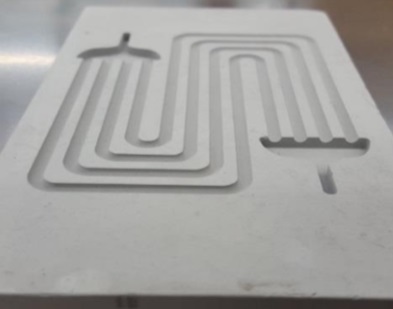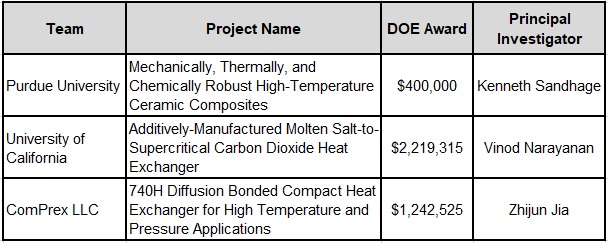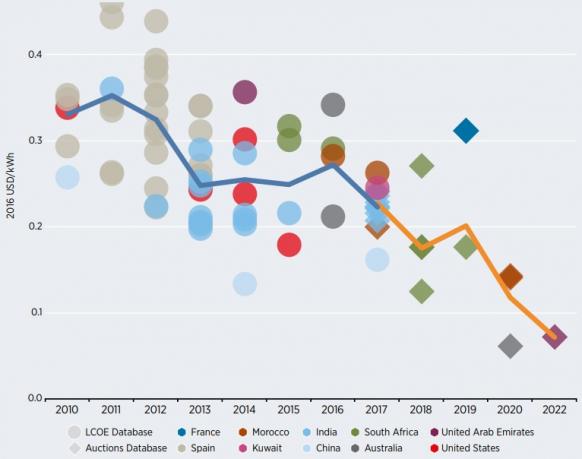CSP heat exchanger breakthrough could lead to 20% cost reduction
U.S. researchers have developed a heat exchanger material for advanced high-temperature CSP plants that can be manufactured at lower costs than existing materials, project leaders told New Energy Update.

Related Articles
Higher-temperature CSP plant designs have been become a key research area for developers seeking to cut costs and widen market opportunities.
Until now, CSP plants have typically used oil or molten salt as heat transfer fluid, limiting temperatures to around 550 degrees C. Higher temperature plants could increase the efficiency of converting heat to electricity, reducing CSP generation costs.
In the U.S., Brayton Energy, the National Renewable Energy Laboratory (NREL) and Sandia Laboratories are all developing CSP plant designs which can heat transfer fluids to over 700 degrees C. The three teams are competing for a $25-million Department of Energy (DOE) grant to build a completely integrated high-temperature system demonstrator at scale.
Higher temperature plants will require more durable components, such as heat exchangers, piping systems and turbines.
Heat exchangers have traditionally been made from steel or nickel-based alloy, but these soften and corrode at higher temperatures.
A group of U.S. universities have now developed a new ‘cermet’ (class of materials made of ceramic and metals) which is proven to be far stronger and more durable than alloys.
Research by Purdue University, Massachusetts Institute of Technology (MIT), Georgia Institute of Technology, UW-Madison, and Oak Ridge National Laboratory (ORNL), has shown the material could be used for heat exchangers in the next generation of high-temperature supercritical carbon dioxide (Sco2) Brayton cycle CSP plants.
“The fracture strength and cost findings indicate that the heat exchanger can be both strong and reliable under the use conditions," Kenneth Sandhage, Reilly Professor of Materials Engineering at Purdue University, and Asegun Henry from the Department of Mechanical Engineering at MIT, told New Energy Update.
Importantly, the cost of the cermet heat exchanger could be equal to or lower than traditional alloy solutions, providing an economic pathway to higher efficiency plants.
A shift to high-temperature Brayton cycle plants could raise heat-to-electricity conversion efficiency by over 20%, the researchers said.
All costs being equal, this could reduce the levelized cost of energy (LCOE) of CSP plants by a fifth.
CSP levelized cost of energy, auction price trends
(Click image to enlarge)
Source: International Renewable Energy Agency (IRENA), January 2018.
Joining forces
Cermets were first developed by engineers working to solve jet engine issues for the U.S. Air Force in the mid-twentieth century. Since then, there have typically been used for small parts in applications such as bioceramics or cutting-tools.
The research team led by Sandhage and Henry developed cermets made from zirconium carbide and tungsten.
Tests showed this material can provide a "highly attractive combination of properties for robust, cost-effective, compact heat exchangers,” the team said in a paper published in 'Nature' in October 2018.
“Optimized fracture strengths, corrosion resistance to sCO2 and thermal conductivity values two to three times greater than those of iron-or nickel-based alloys at (over 700 degrees C) are the principal performance outputs to emerge from the testing phase,” the researchers told New Energy Update.
Cost analysis by UW-Madison and ORNL found that the cost of the new heat exchangers would be comparable or lower than compact nickel-based alloy solutions. Tests showed that lower manufacturing and labor costs for the cermet solution outweighed higher source material costs.
Faster manufacturing
Traditional metal alloy plates used to make printed circuit heat exchangers are typically manufactured using state-of-the-art photochemical etching.
The cermet solution is manufactured by a mechanical joining of a porous tungsten carbide preform plate with a channelled tungsten carbide preform plate, using a Displacive Compensation of Porosity (DCP) and diffusion bonding process.
This means the material can be manufactured using "cheaper and faster" methods than metal alloy designs, the researchers said.
“This is where the cost reduction comes from,” they said.
Earlier uses of cermets involved smaller applications and application of these materials in a larger heat exchanger is a significant advancement.
The researchers are now developing a manufacturing process for the scaling up of the cermet heat exchanger design.
This work will define the equipment and expertise required from future manufacturing partners, Sandhage and Henry said.
“We’re hoping to develop such relationships within 3 to 6 years after successful completion of the current projects,” they said.
New benchmarks
A number of other teams in U.S. and Europe are developing materials and components for high temperature plants.
In October, the DOE awarded $3.8 million to scientists from Purdue University, the University of California, and ComPrex, Wisconsin.
These teams will examine how novel composites, reduction in structural size and enhanced fabrication methods can improve heat-exchanger performance.
DOE CSP heat exchanger research funding (Oct. 2018)

Source: US Department of Energy (DOE)
Sandhage predicts further materials improvements on the horizon.
Purdue researchers have identified new composites which could further improve the performance of high-temperature heat exchangers and other components, he said. The researchers are currently developing the intellectual property rights for these.
These materials have yet to be used in the energy industry and greater knowledge will be required before they can be commercialised, Sandhage noted.
Developers would require an understanding of "new mechanisms for corrosion and materials degradation" to harness the benefits of these products, he said.
By Kerry Chamberlain

